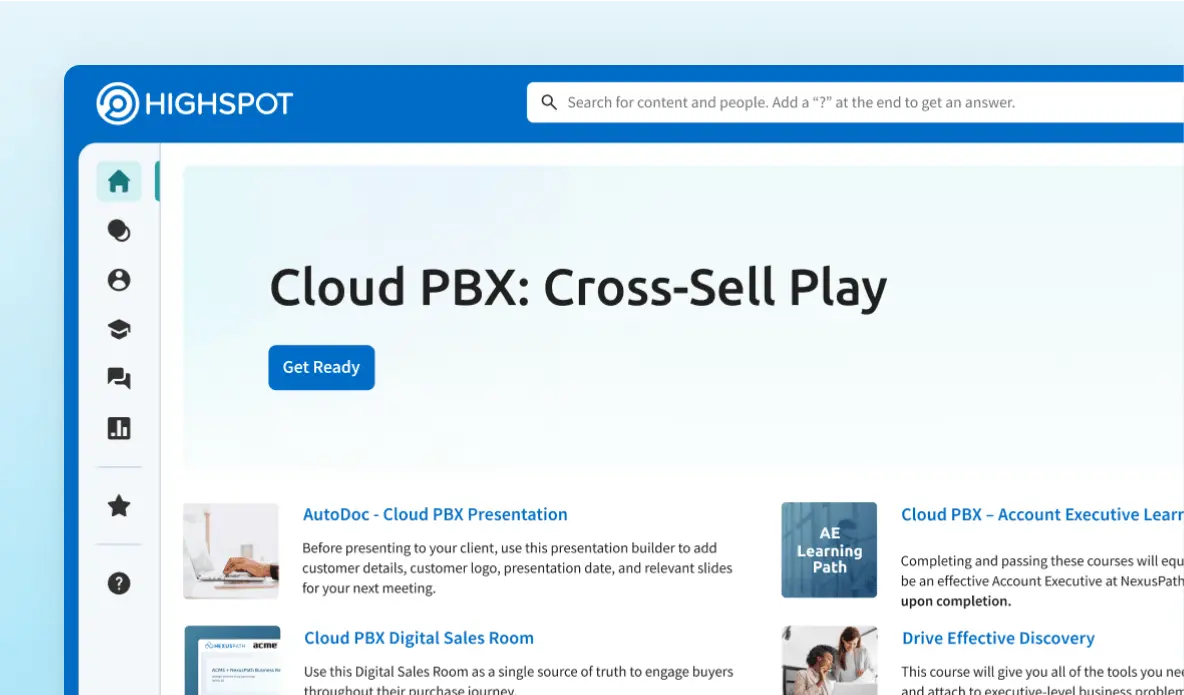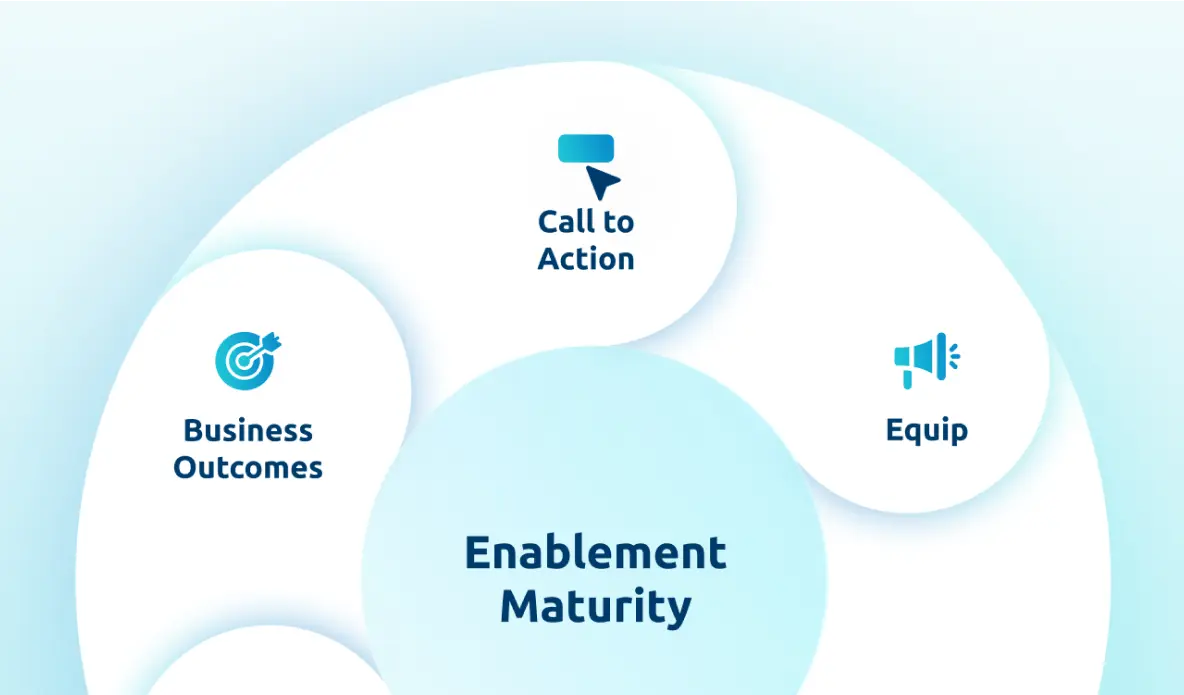Find out how PagerDuty improves the B2B sales experience for buyers by having its reps build personalized digital sales rooms.
According to research from McKinsey, 70-80% of B2B decision makers prefer remote or digital self-service interactions. So how can you leverage your enablement tech stack to improve the digital buying experience and boost buyer engagement?
Shawnna Sumaoang: Hi, and welcome to the Win-Win podcast. I’m your host, Shawnna Sumaoang. Join us as we dive into changing trends in the workplace and how to navigate them successfully.
Here to discuss this topic is Lisa Brown, the senior instructional designer at PagerDuty. Thank you for joining us, Lisa. I’d love for you to tell us about yourself, your background, and your role.
Lisa Brown: Hi! It’s nice to be here. So, prior to working in enablement, I spent several years working in education at various levels from elementary all the way up to higher education.
But the thing that I loved most about those roles was when I got to create learning programs and training materials. So eventually I made the jump into enablement as an instructional designer about seven years ago. I’ve now been at PagerDuty for almost three years, and like you said, I’m the senior instructional designer that supports field enablement.
So in my role, I create training materials, e-learnings, I consult on adult learning principles, and I also support the administration and architecture of Highspot.
SS: Amazing. And on the note of Highspot, I know that your organization implemented Highspot earlier this year, making the switch from a previous enablement platform. Can you tell us about some of the key things that your team is prioritizing this year and how that led you to evolve your enablement tech stack?
LB: Yeah, so one of our biggest priorities this year has been focused on data-driven enablement. When we made the switch to Highspot, we wanted to move beyond just responding into a motion that was more proactive.
We’re looking closely at what the data is telling us. Things like what content the field is actually using, what’s being searched for in our platforms and where there could be gaps. This way we can partner with leadership to plan more meaningful enablement that might fill those gaps. This visibility into the data has also helped us take a more strategic approach to the content curation that we’re working with by developing a more structured governance plan.
We’re not just filling a library with content, removing what’s outdated. We’re highlighting what’s working, and we’re making sure that everything that’s available is relevant and easy for the field to find. This is also really helping us strengthen our feedback loops with other departments by having a structured governance in place.
Content contributors and SMEs are charged with more regular evaluation of their content. Things like, is it up to date and current? Is it relevant still? Is it being used by the field? And this allows more insights for them as they’re updating their content as well as our own means for data evaluation.
But it’s also continuously providing value to our field users because they can remain confident that the content that they’re using is the most accurate information and it’s the most up-to-date. So I think to summarize, for us, it’s all about making that seller experience much more smooth and impactful.
It’s making it easier for them to get what they need when they need it, so that they can focus on building relationships and driving results with their customers, not on finding content.
SS: I love that. And another area where you have already started to see amazing success is through the use of Digital Rooms. I’d love it if you could share a little bit more about the role that Digital Rooms are playing in your enablement strategy.
LB: Yeah, so when we rolled out Highspot, we knew that driving excitement and adoption would be critical, especially because this was another tool change for our field, and you can get a lot of fatigue from that.
So we really leaned into the value of Digital Rooms, almost like a marketing hook internally. Rooms were not just a new feature. They represented a new way to engage with customers more personally. Digital Rooms allow the field to deliver a curated and branded experience that’s not only more engaging for the buyer, but it also provides more data for the seller.
We can see who’s opening what, how long they’re spending on the content, how long they’re spending in the room, and then we can use that to coach our reps on follow ups and personalization as well as the benefit that they’re seeing and that they can make their own decisions on. Now that we are a few months out from our launch, we are embedding digital room usage into other training programs across all of our enablement programs.
We’re incorporating it into the deal strategy especially for complex sales and renewal motions where we all know that that relationship building is especially critical.
SS: Absolutely. And what are some of the challenges that you’ve seen reps face today, and how are you leveraging Digital Rooms to help solve these challenges?
LB: One of the biggest challenges that our reps are facing is getting to the right buyer and not stopping at a single point of contact. We know how important multi-threading is, especially in today’s buying environment, where decisions often involve multiple stakeholders across different levels of an organization.
So that’s where digital rooms have really become a strategic tool for us. We’re not using them just to share content, but we’re using them to open up the buying committee because the digital room is something that our champions can share internally. We’re seeing it lead to the creation of new contacts that we might not have access to otherwise or without using this tool.
Another key benefit that we’re getting from this is the engagement data. Like I said, reps can see what’s being viewed by who and how often, which is giving them a much clearer picture of what the customer is actually interested in and where they might need to pivot the conversation or go deeper in that conversation.
Overall, we see Digital Rooms as a way not to just deliver content, but to gain visibility, create momentum inside the customer’s organization, and drive more strategic engagement with potential customers or existing customers.
SS: Can you tell me a little bit more about that? What are some of your best practices for building effective Digital Rooms?
LB: So our best practices, I’ve tried to kind of summarize it, narrow it down a little bit, but I think the biggest way to summarize it is really comes down to being intentional and buyer centric. From the start, we’ve encouraged our reps to start with the buyer in mind, which means customizing the room based on the customer’s industry, the role and their specific pain points.
The content in those rooms should really feel like it was curated for their industry, their role, their pain points, other than just being a generic collection of assets. Second, we’ve advised our reps to build the digital room early in the buying journey, ideally right after the first meeting or contact, and then treat it like a living resource.
After every call or email exchange, the room gets updated with relevant follow-ups, next steps or new content that might have been discussed or that could be relevant. It becomes a shared space that really reflects the progress of the deal by doing that. Another key best practice that we have is to use the metrics, and I know I keep talking about the metrics, but they’re so important with, I think every industry today.
The Engagement Center really provides a lot of insight into what the customers are actually spending time with, which is giving them a much clearer picture of what content is relevant or if we need to reframe conversations in any way. And then when we see someone new accessing the room and the content that they’re accessing, it often means that the deal could be expanding internally, which gives the reps a natural reason to either follow up or to create new contacts and multithread that relationship.
SS: Amazing. Well, like I said, you guys are doing amazing things with Digital Rooms now. When you were rolling out Digital Rooms to your teams, you led a series of workshops at your regional enablement summit for your global teams. How did you design and deliver these workshops?
LB: Yeah, it was really great timing because we had already scheduled our regional enablement summits, and it happened to fall shortly after we enabled Highspot, so it was just really perfect timing for us.
I started designing these workshops by assessing the baseline familiarity with Digital Rooms. By our teams at PagerDuty. Looking at the data from our former platform, over 90% of our current field reps had used a Digital Room before. Over 90% of people had never touched a Digital Room here at PagerDuty.
That told me that we really needed to start with the fundamentals, not just the how to, but also the why. So the workshops began with an overview of what Digital Rooms are, why they matter, and how they support both the buyer journey and our internal selling process. From there, I moved into the practical side by introducing how reps could upload custom content or customer specific content into their personal spots, so that way it was ready to drop into a digital room whenever it was needed.
And then we covered off best practices, things like content curation and visual presentation, and then using the metrics to guide the further engagement with their customers. Next, I walked through a demo of building a Room, but the most important part of this was when we allowed for hands-on practice in that Room.
It was a safe, non-customer facing environment, so I really wanted to allow the field to get their hands on the tool. Explore it, make mistakes, ask questions, and get support from me and my team that were in the Room, and this was all before they were sending anything to a customer. No customer was going to see this, so it was really, really a safe space for them.
I wrapped up with clear next steps, like sending your first room and then reviewing engagement metrics. Partnering with your manager to strategize those follow-ups, so that way they had a really clear plan of action to leave the room with. I think that that combination of education, practice, and action made our rollout feel approachable and immediately applicable for the field.
SS: I love that. Well, like I said, as I’ve alluded to, you guys have seen an impressive adoption since the rollout with over 300 external shares of Digital Rooms. What have been your best practices for driving and maintaining high adoption?
LB: So a big part of our adoption success came down to how we launched.
I mean, I just talked about it, but we didn’t just announce Digital Rooms and say have at it. We built a foundation through our in-person training, and that allowed us to get the reps comfortable with the tool in a hands-on and low pressure setting. They had time to practice and ask questions before feeling the pressure of, oh, this is going to get sent to a customer.
This was just a safe space for them to practice. We also emphasized why the rooms matter, not just what they do, and framing them as tools that support multi-threading personalization and deeper customer engagement helped the reps understand the strategic value, and it really connected with a lot of what they’re struggling with right now.
So it made the tool even more meaningful and has helped our adoption stay a lot stickier. Since launch, we have been working on keeping the momentum going by highlighting success stories, building a library of assets to make the rooms easier to build and reinforcing best practices through manager enablement and follow-up training.
We’re really trying to make it as easy as possible to use while showing the value and celebrating our wins along the way.
SS: I love that. I think celebrating those wins is absolutely important. And along with driving high adoption, you’ve also seen really great customer engagement. Can you tell us about the impact Digital Rooms are having on the buyer experience?
LB: We have heard from our sellers that one of the biggest things that customers appreciate about the digital rooms is simply the convenience of it. They have everything in one place. Instead of having to dig through tons of emails or links that might have been shared or various slacks, they instead, they just get a centralized hub that’s clean and organized and tailored exactly for their needs.
A great example of this came from one of our reps after our cornerstone event called PagerDuty on tour that we held this spring. This rep created a Digital Room as a follow-up, not just for the attendees that were at the event, but also for customers who weren’t able to make it. It included highlights from the event, key resources and next steps all in one single place.
It turned what could have been a very generic thank you email into something that was more personal and valuable to those customers, whether or not they attended the event. That kind of personalized follow-up keeps the conversation going and it shows the customer that we’re thinking about their experience and not just our internal sales process.
And because the room is dynamic, those reps can continue to update it as the relationship evolves, which keeps that engagement alive long after the initial touchpoint. So from a buyer experience standpoint, Digital Rooms are helping us move away from those transactional follow-up emails towards a more thoughtful relationship based engagement.
SS: Very cool. And after seeing some of these early wins, what are you hoping to achieve next as you continue to evolve how your teams are leveraging Digital Rooms?
LB: Now that we’ve laid the groundwork and seen strong early adoption, our next focus is on depth of usage and consistency. We want to ensure that the field continues to use the Digital Rooms, they maintain them as a living asset during their deals, and that they can continue to use the engagement metrics to help drive next steps and actions.
We’re also working on building out more examples that are industry specific to make it even easier for our reps to scale their efforts while driving personalized experiences. This is in addition to highlighting good examples from the field and the successes that they’ve seen, because I think it’s really important to have that peer-to-peer learning element and have that engagement within the field themselves.
From a measurement standpoint, we’re looking to tie engagement with Digital Rooms to deal outcomes so that we can better understand where our reps are moving the needle.
SS: How exciting. Oh, last question for you, Lisa, and again, I appreciate you taking the time to talk us through all that you guys have done at PagerDuty. I would love to understand if you could give one piece of advice to other teams looking to get started with Digital Rooms, what would it be?
LB: My biggest piece of advice is to start simple and make it applicable. Focus on creating space for your teams to get hands on and give them a safe environment to explore the tool.
Build those templates that they can immediately use with their customers and also show them how using a Digital Room maps to their existing workflows so that it makes it as easy as possible for them to start implementing the tool in their day-to-day without it stressing them out about just another tool that they have to use. It’s something that they want to use to keep their buyers engaged.
SS: I love that advice. I absolutely love that. Well, again, Lisa, thank you so much for joining us. I really appreciate your time today.
LB: Thank you. I appreciate it.
SS: To our audience, thank you for listening to this episode of the Win-Win podcast. Be sure to tune in next time from our insights on how you can maximize enablement success with Highspot.




